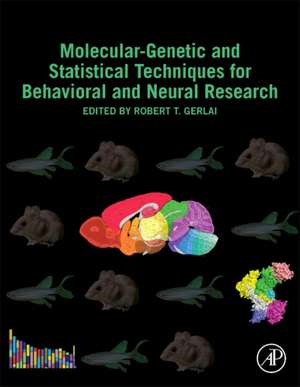Molecular-Genetic and Statistical Techniques for Behavioral and Neural Research
Editat de Robert T. Gerlaien Limba Engleză Hardback – 26 apr 2018
Written and edited by leading international experts, this book provides a clear presentation of the frontiers of basic research as well as translationally relevant techniques that are used by neurobehavioral geneticists.
- Focuses on new techniques, including electrocorticography, functional mapping, stereo EEG, motor evoked potentials, optical coherence tomography, magnetoencephalography, laser evoked potentials, transmagnetic stimulation, and motor evoked potentials
- Presents the most exciting molecular and recombinant DNA techniques used in the analysis of brain function and behavior
- Written and edited by leading international experts
Preț: 805.33 lei
Preț vechi: 1114.17 lei
-28% Nou
Puncte Express: 1208
Preț estimativ în valută:
154.11€ • 161.43$ • 127.72£
154.11€ • 161.43$ • 127.72£
Carte tipărită la comandă
Livrare economică 01-15 aprilie
Preluare comenzi: 021 569.72.76
Specificații
ISBN-13: 9780128040782
ISBN-10: 0128040785
Pagini: 708
Dimensiuni: 191 x 235 x 35 mm
Greutate: 1.57 kg
Editura: ELSEVIER SCIENCE
ISBN-10: 0128040785
Pagini: 708
Dimensiuni: 191 x 235 x 35 mm
Greutate: 1.57 kg
Editura: ELSEVIER SCIENCE
Public țintă
Neuroscientists, biomedical researchers, grad students, postdocsCuprins
Section I: Neuroinformatics, Computational Models and Data Analysis
1. Neurological Biomarkers and NeuroInformatics: The Role of The Virtual Brain
2. Informatics for Interoperability of Molecular-Genetic and Neurobehavioral Databases
3. The Allen Brain Atlas: Towards understanding brain behavior and function through data acquisition, visualization, analysis and integration
4. ExAtlas: On-line tool to integrate gene expression and gene set enrichment analyses
5. Computational Models: How do they help to understand neurological diseases?
6. The Use of Recombinant Inbred Strains in Systems Genetics and Functional Analyses in Behavioral Pharmacology
Section II. Searching for New Genes: Natural Genetic Variation
7. Spontaneous versus induced mutations: Conceptual and methodological considerations for the neurobehavioral geneticist
8. Reduced complexity cross design for behavioral genetics
9. Collaborative Cross as the next-generation mouse genetic reference population designed for dissecting complex traits
10. Discovery of novel genes and other lineage-specific features through comparative genomics
11. Using signatures of directional selection to guide discovery
Section III: Discovery of New Genes and New Functions of Genes Using Gene Expression Analyses
12. Using Transcriptomics to Study Behavior
13. Genes, Behavior and Next-Generation Sequencing – The First Ten Years
14. Abnormal social behaviors and dysfunction of autism-related genes associated with daily agonistic interactions in mice
15. Epigenetic mechanisms of learning and memory
Section IV: Discovery of Genes and Biological Mechanisms: Forward Genetics and Other Screening-Based Methods
16. Systematic screens in zebrafish shed light on cellular and molecular mechanisms of complex brain phenotypes
17. The transition of zebrafish functional genetics from random mutagenesis to targeted integration
Section V: Manipulating Known Genes to Understand Biological Function: Reverse Genetics
18. Molecular Techniques Used to Explore Glutamate Receptors in Synaptic Plasticity and Memory
19. Using Herpes Simplex Virus Type-1-Based Amplicon Vectors for Neuroscience Research and Gene Therapy of Neurological Diseases
20. Cre-lox neurogenetics: history, present and future
21. Functional Analysis of Proteins Involved in Neurodegeneration Using the Model Organism Dictyostelium: Alzheimer’s, Huntington’s and Batten Disease
22. The role of human endogenous retroviruses (HERVs) in the pathologies of nervous system
23. Optogenetics dissection of sleep circuits and functions
24. The use of DREADDs for dissecting the contribution of cellular and neural circuit mechanisms in models of neurodegenerative disease
Section VI: Ethical Considerations
25. Genes and human behavior: Ethical implications
26. Ethical Considerations for Animal use in Behavioral and Neural Research
1. Neurological Biomarkers and NeuroInformatics: The Role of The Virtual Brain
2. Informatics for Interoperability of Molecular-Genetic and Neurobehavioral Databases
3. The Allen Brain Atlas: Towards understanding brain behavior and function through data acquisition, visualization, analysis and integration
4. ExAtlas: On-line tool to integrate gene expression and gene set enrichment analyses
5. Computational Models: How do they help to understand neurological diseases?
6. The Use of Recombinant Inbred Strains in Systems Genetics and Functional Analyses in Behavioral Pharmacology
Section II. Searching for New Genes: Natural Genetic Variation
7. Spontaneous versus induced mutations: Conceptual and methodological considerations for the neurobehavioral geneticist
8. Reduced complexity cross design for behavioral genetics
9. Collaborative Cross as the next-generation mouse genetic reference population designed for dissecting complex traits
10. Discovery of novel genes and other lineage-specific features through comparative genomics
11. Using signatures of directional selection to guide discovery
Section III: Discovery of New Genes and New Functions of Genes Using Gene Expression Analyses
12. Using Transcriptomics to Study Behavior
13. Genes, Behavior and Next-Generation Sequencing – The First Ten Years
14. Abnormal social behaviors and dysfunction of autism-related genes associated with daily agonistic interactions in mice
15. Epigenetic mechanisms of learning and memory
Section IV: Discovery of Genes and Biological Mechanisms: Forward Genetics and Other Screening-Based Methods
16. Systematic screens in zebrafish shed light on cellular and molecular mechanisms of complex brain phenotypes
17. The transition of zebrafish functional genetics from random mutagenesis to targeted integration
Section V: Manipulating Known Genes to Understand Biological Function: Reverse Genetics
18. Molecular Techniques Used to Explore Glutamate Receptors in Synaptic Plasticity and Memory
19. Using Herpes Simplex Virus Type-1-Based Amplicon Vectors for Neuroscience Research and Gene Therapy of Neurological Diseases
20. Cre-lox neurogenetics: history, present and future
21. Functional Analysis of Proteins Involved in Neurodegeneration Using the Model Organism Dictyostelium: Alzheimer’s, Huntington’s and Batten Disease
22. The role of human endogenous retroviruses (HERVs) in the pathologies of nervous system
23. Optogenetics dissection of sleep circuits and functions
24. The use of DREADDs for dissecting the contribution of cellular and neural circuit mechanisms in models of neurodegenerative disease
Section VI: Ethical Considerations
25. Genes and human behavior: Ethical implications
26. Ethical Considerations for Animal use in Behavioral and Neural Research
